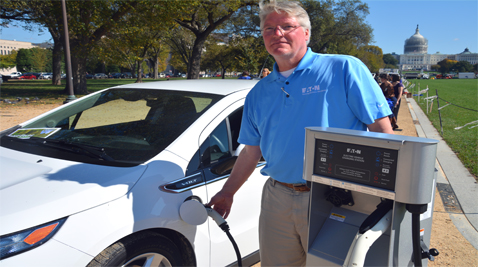WASHINGTON – The nation’s largest clean vehicle awareness event kicked off Friday on the National Mall with an exhibit featuring automotive technology and industry solutions.
The event, named “Odyssey,” is the seventh biennial celebration created and sponsored by the National Alternative Fuels Training Consortium to promote the use of alternative fuel and advanced technology vehicles.
Since its inception in 2002, Odyssey has grown to attract more than a quarter million attendees in more than 40 states, according to the consortium’s website.
Judy Moore, a spokeswoman for the consortium, said that over the course of 12 years the group has been able to reach more than 400 million individuals through its events and the media coverage they’ve generated.
Offering more than 25 workshops and courses dealing with the development of alternative fuel and the use of advanced technology vehicles, the consortium offers training projects to the U.S. Environmental Protection Agency in the field of emissions testing and the use of a variety of alternative fuels.
Terry Wolfe is one of the consortium’s instructors. A retired automotive director from the Community College of Baltimore County, Wolfe has more than 10 years of experience teaching training classes for the consortium’s customers.
“Our classes deal with a variety of fuels from biodiesel, ethanol, propane, natural gas to electric, hydroelectric and hydrogen. Essentially, the curriculum is fuel-neutral as there is a value in embracing different alternatives and understanding strengths and weaknesses associated with them,” said Wolfe, whose audience varies from technical professionals to car sales personnel.
This year’s kickoff event is themed “Driving toward a clean, secure energy future” and is hosted by The Greater Washington Region Clean Cities Coalition, a non-profit, public-private partnership that brings together organizations, businesses and government agencies.
Represented by about 100 local chapters across the country, the Clean Cities efforts have brought about savings of over five billion gallons of petroleum since the partnership was established in 1993, according to their report.
Ronald Flowers, executive director for the local chapter, said the coalition’s projects in the Washington region are responsible for 12 million gallons of gasoline reductions and more than 60,000 tons of greenhouse reductions this year alone.
“When you leave today, go to somebody and say something to them about them making a difference. And that difference is in the use of some kind of alternative fuel initiative. For example, when you go to pick up your child from school, instead of sitting there for 20 minutes and running the engine, turn it off. That saves fuel,” said Flowers, telling an audience at the event how they can contribute to emission reductions.
Nancy Bechtol, director of the Office of Facilities Engineering and Operations at the Smithsonian Institution, said that managing a more than 400-vehicle fleet is one of the major aspects of the Smithsonian’s sustainability program.

Smithsonian institutions have been able to reduce their petroleum fuel consumption by 15 percent for the past nine consecutive years, she said. Of the 438 vehicles – some of which are used to transport items ranging from totem poles to living hippopotamuses – about a quarter are equipped with non-combustion engines.
“We are very proud of our statistics, we want to double those numbers and we work hard to do that,” said Bechtol, adding that the only constraint has been funding.
A number of companies from around the country were showcasing their vehicles and technology Friday at the National Mall.
Geoffrey Markovic, lead sales engineer at Eaton Corporation, whose office is based in Hanover, displayed the company’s dual electric vehicle charging station. The station features two ports able to charge two cars at once using a single pedestal unit.
“Usually such stations have only one port. Equipped with two, our model expands its service facility while retaining the same footprint,” said Markovic.
According to the engineer, with a typical 24-kilowatt-hour battery capacity of the electric engine available on the market, it takes about six to eight hours to completely charge a car.
“Stations can be suitable for general stores, shopping malls, airports, any place where you would go to park a car,” said Markovic. “But we also have a version for residential use, which you would have in your garage.”
He added that at an average cost of 11 cents per kwh, a car owner would have to pay $2.60 to recharge a battery that can last for about 100 miles.
The kickoff day on the National Mall will be followed by more than 100 events around the country, featuring government agencies, environmental organizations, businesses and schools.


You must be logged in to post a comment.